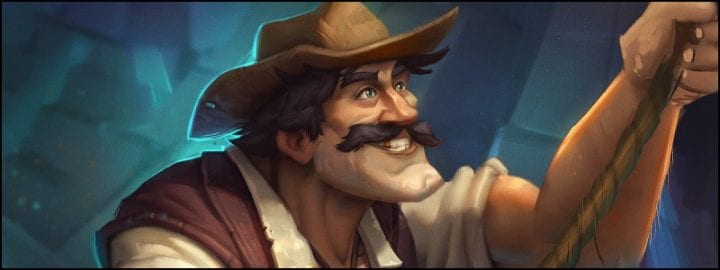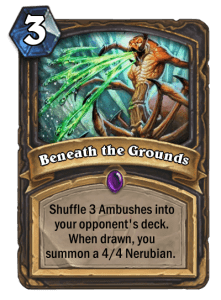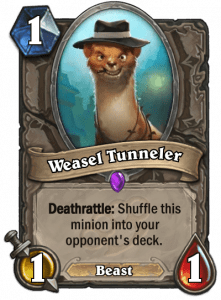
Reno Decks: Basics, Counters and Feasibility of Duplicates
by OtakuMZ - 7 years ago show comments
Introduction
When Reno Jackson was first introduced in the League of Explorers Adventure, a lot of players doubted the viability of Highlander decks (decks with only one copy of each card) which we all know today in the Hearthstone universe as Reno decks. As it turned out, the doubts were unjustified, but these decks remained a niche pick and were mostly played by specialists only. This changed tremendously with the introduction of Mean Streets of Gadgetzan (MSG). Not only did Mage, Priest, and Warlock get access to two ‘if your deck contains no duplicates’ cards but, atop, the card pool we have access to in Standard is at its largest we ever had.
Reno-Style Cards and Decks
Kazakus is a powerhouse that has an impact comparable to Reno Jackson himself allowing for huge swing turns. The other fall off more or less ranging from Raza, the Chained being a staple in Reno Priest, Inkmaster Solia being a viable pick but not a necessity for Reno Mage to Krul the Unchained not seeing much play. Despite Krul played little to none, Reno Warlock (short: Renolock) is the Reno deck mostly played at the moment. The conceived power level of the deck varies. On the one hand, the TempoStorm MetaSnapshot of Dec. 19th ranks it tier. On the other hand, it is sitting at tier 3 in the Vicious Syndicate Data Reaper Report #30 (VS DRR). In any case, it is not an easy deck to pilot, but nonetheless powerful in skilled hands.
The problem of Reno decks in general at the moment is Miracle Rogue which soft counters Renolock because of its burst potential. Likewise, Pirate Warrior is able to overwhelm Gul’dan more often than not. Don’t forget Reno Mage, which is a force to be reckoned against it. Nevertheless, the deck has favorable match-ups against most of the prevalent decks: Aggro and Midrange Shaman, Dragon Warrior and Dragon Priest. These statistics render it a still viable deck to climb the ladder, more so because Miracle Rogue sees less play until Legend ranks.
Reno Mage and Reno Priest are in a similar spot but being much less frequently played whereas Reno Mage is favored against Renolock and Reno Priest is at a disadvantage. For all an exact match-up overview, compare the highlighted lines in table below from the VS DRR#30
Counter Cards to Reno Decks
Beneath the Ground
This is a really dirty trick that rogues have up their sleeves. This card disrupts Reno decks by disabling the cards that benefit from having only a single copy in the deck by putting a triple in – nasty! Play this in an aggressive Rogue against highlander decks and you can pursue the strategy of bursting them down and disabling their health regeneration. The downside is, that against other control decks, the strategy is a lot less effective if not useless.
Weasel Tunneler
Isn’t he a cutie? The Weasel is also able to disable Reno decks in a similar way to Beneath the Grounds but a whole lot less reliant. You have to draw both and they both have to die. Also, between the death of both rodents, your opponent must not draw the first copy. To be honest, it is cited here more for being complete than being viable. BtG is the way to go when disrupting Reno decks.
Running Duplicates: A Good Idea?
When composing a Reno deck, there is always a card that you would like to put in twice, right? In any case, Reno, Raza and Co. trigger once one copy of the dupe gets drawn. But what are the odds of that and does running one or multiple doubles really impair the core cards of the list? Let’s take a look at a graph from a post that was published in the Hearthstone subreddit by JimboHS.
The graph shows, dependent on the number of duplicates, what are your chances to activate Reno Jackson and likewise cards.
I will give you a couple examples to make my point. First, we look at only one dupe in your deck. Then we do the same thing with two, three and five. To keep the article readable, we will assume that you hard mulligan for the duplicates every time. In the end, they seem so important to put them into the deck in the first place. I will give you two numbers for each of the examples: the number of cards left in the deck to get an 80% or greater and a 95% or greater chance to being able to play enabled Reno cards.
Example 1: one duplicate
- >80% chance: 13 cards left
- >95% chance: 6 cards left
Example 2: two duplicates
- >80% chance: 11 cards left
- >95% chance: 5 cards left
Example 3: three duplicate
- >80% chance: 10 cards left
- >95% chance: 4 cards left
Example 4: Five duplicate
- >80% chance: 7 cards left
- >95% chance: 3 cards left
Even with only one duplicate, you have to draw more than half of your deck to have an 80% chance to being able to fully heal or to get a Kazakus potion. In the actual meta, with decks that try to finish you by turn 6, playing dual copies of any number seems not a good idea at all. Therefore, I highly recommend to stick to the full one copy of each card in the deck theme.
That’s it for today, I hope you enjoyed this short insight into Reno decks and strategies. If you like to leave a comment, you can do so below or tweet me @OtakuMZ1978.







